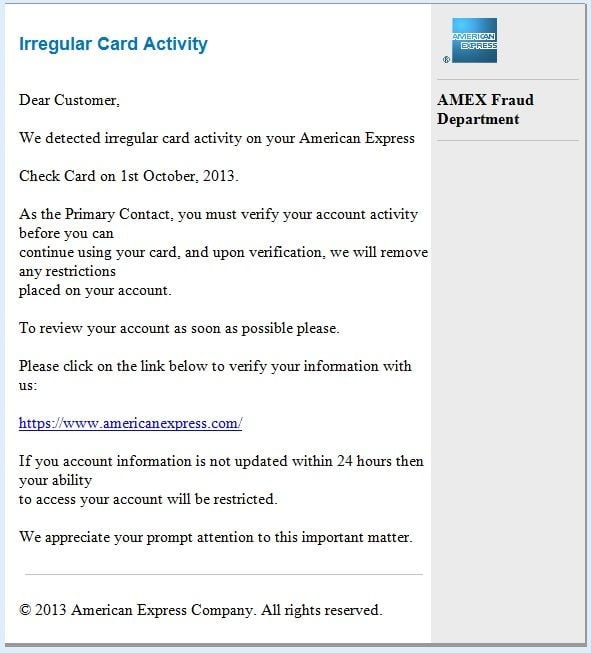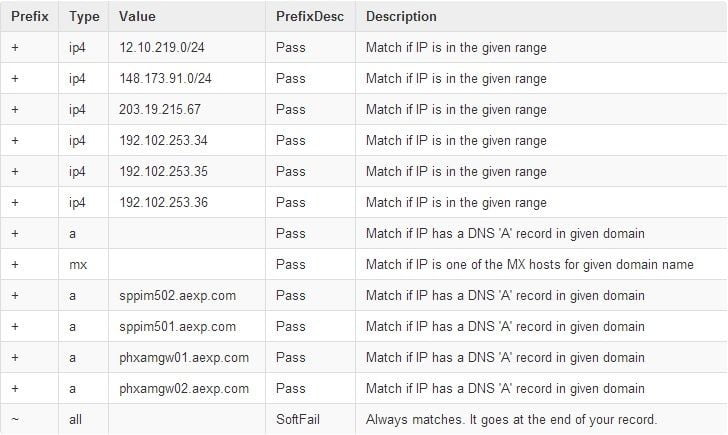
Who is Lucky Brand?
For anyone who is unfamiliar with the name, Lucky Brand is the maker of Lucky Jeans. According to their website, they have 209 stores all over America, sell their clothing line in department stores as well as online retailers.
I’d like to preface this story with a disclosure; Lucky Jeans are my all-time favorite jeans. They fit great, have an awesome look and are the most comfortable jeans I own. I probably have 7-8 pairs sitting in my closet, with the oldest pair being 12-15 years old.
Last month, my wife and I were walking in the local mall, when we passed the Lucky Brand store. I decided to go in and look around. The salesperson was extremely knowledgeable about the brand and styles. He explained the different “models” to me and how they fit and my wife ended up buying me a pair of $129 jeans. Yes, you heard me right. The jeans were $129 + tax. While the price even seems crazy to me, I consider them an investment in my wardrobe and will likely have this pair for 10+ years. The salesperson also explained to me that Lucky had a Model 181 which was more of a relaxed fit jean, but they did not sell them in the stores, only on the Lucky Brand website.
The Lights Are On, But There’s Nobody Home
So, when I got to work the next day, I logged on to the Lucky Brand website, signed up for their newsletter to receive a discount (as stated in the newsletter signup pop-up message that appeared) and proceeded to find the Model 181 relaxed fit jean, picked my size and attempted to place my order. I was then asked to create an account and to my amazement, noticed that the website was not secure. Thinking this was some type of oversight or a new error, I then sent Lucky a message to the customer support email address I found on their website.
Below is the email message I sent:
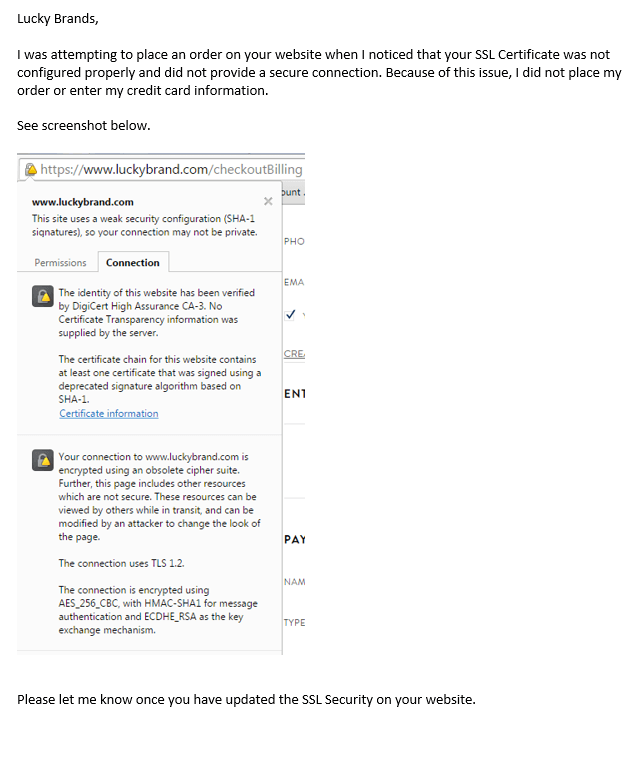
Six hours and nineteen minutes after I sent the email above to their customer support, I received a response. (See below)
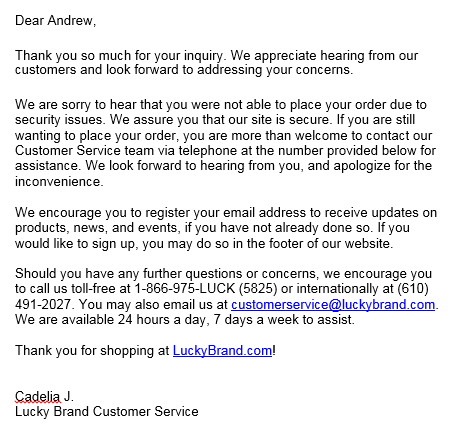
Besides the reply seeming very canned and generic, the first of many mistakes made by Lucky is to allow interns, uneducated or untrained staff to respond to consumer inquiries, especially concerning website or ordering issues. Based on my email and the rationale why I didn’t place my order (the site being unsecure) why would Cadelia J. (the customer service rep) respond to me with, “We assure you that our site is secure”, when it’s obvious that it is not secure and the only reason I sent them an email to begin with. Then she suggests that I contact their Customer Service team, via telephone. Sure, that’s exactly what I want to do; call and give someone my credit card information over the phone who will simply type it into the same unsecure website I didn’t want to type my information into originally.
As soon as the shock of stupidity wore off, I promptly responded to the above email with the reply below.

And the reply to my email, received on September 25, which came from Elizabeth G., a different customer service person at Lucky Brand. (See below)
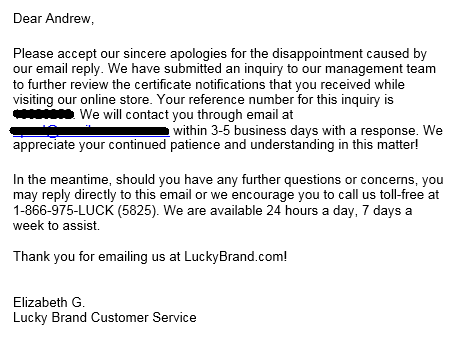
Sadly, the 3-5 days has come and gone a long time ago, I’m glad I wasn’t holding my breath and I never heard from anyone at Lucky Brand ever again. While this was not anticipated, it is still very disappointing, especially for such a large brand. Their website is still unsecure, which is utterly amazing to me. How a company, that claims to generate $100 million in annual sales, could drop the ball and allow something like this to occur is beyond me.
There is One Failure After Another – But Wait, I’m Not Finished Yet
Since I still wanted to buy these Lucky Jeans, I decided to look on Amazon for them, and voila – there they were, perched among all of the other Lucky Jeans. So, I picked my size and color and placed my order. Now hold on because here comes the best part…… They were $79.00 and I got free shipping. What’s even better is they were sold by Lucky Brands and fulfilled by Amazon. A few days later, my new jeans arrived and they are as expected, simply awesome.
Email Marketing – The Clueless Continuation
Sometimes I wonder if the lights are simply left on and there’s nobody home, because it sure seems that way here. I made the mistake of signing up for Lucky Brands’ email newsletter and now I’m stuck in newsletter hell. Every time they send out a newsletter, I receive 2 identical newsletters simultaneously. (See below)

Then I noticed they were sending newsletters every day. So, now I’m receiving 2 identical emails from them daily. It get’s worse – it’s the same email creatives rotated every few days. It’s either 40% off, 50% off or mystery percentage off (just go to the website to find out what percentage off you’ll receive). So I decided enough is enough and tried to unsubscribe. I clicked the unsubscribe link and was brought back to their home page. Thinking they just weren’t bright enough to bring me to an unsubscribe confirmation page, I concluded that’s it, no more emails from Lucky, hallelujah. Not So Fast – guess again – the emails kept coming – 2 at a time. I then thought to myself, maybe it’s a browser issue and tried the unsubscribe link in Firefox and Internet Explorer, because Chrome didn’t seem to work. In IE it finally worked and I was brought to the page seen below.
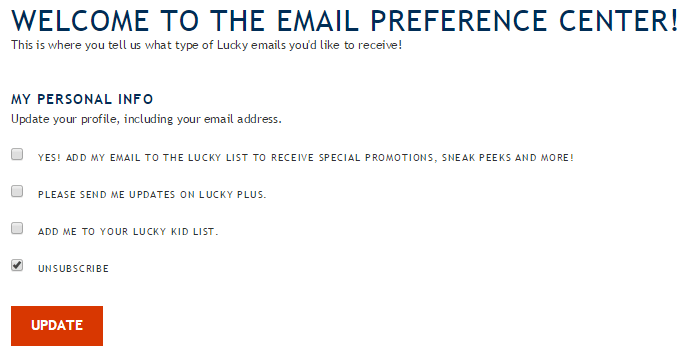
Now I figured I’m done with this. I made sure “Unsubscribe” was ticked and clicked “Update”. I was brought to a page that said “Thank You” (See below)

Now You Think We’re Done Right? Think Again
Did you possibly believe it could be this easy? I did – why? I have no idea. You guessed it, the emails kept coming – 2 at a time. To end this fiasco, I simply clicked the spam button so that all Lucky Brand emails simply go into the junk/spam folder. What’s even more amazing to me is that Lucky has still not fixed the SSL Certificate issue on their website. I cannot imagine how much business they are losing from this simple configuration fix and what its costing them. I can’t be the first person who brought this to their attention, nor can I assume I’ll be the last. So why haven’t they fixed it? Why is their email marketing program, deployments, frequency and creative choices so poorly managed for such a large company? I agree, I have no clue either.
Surprise, Surprise, Surprise – Lucky Brand files for bankruptcy July 2020. Why am I not surprised?

